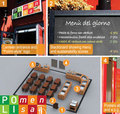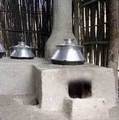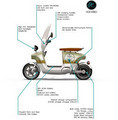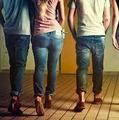Sourcing Local Colour
by: Centre for Sustainable Fashion, 2013-11-11 13:13:02 UTC

Caption: One of many pages of color samples gained from plants in London
One of the many things one has to consider when creating material goods is the source of their colour. This week the Centre focuses on natural dye, a specialty currently seeing a huge surge in interest.
Natural dyes are those derived from animal, plant or mineral sources as opposed to synthetic dyes which are petrochemicals.
Without switching to natural dyes there are many ways in which designers and brands can and should take steps to see that their designs are made with low-impact dyes and there are many situations where natural dyeing would not be the best choice.
But what natural dyes offer is a possibility of colourful clothing and textiles created as part of a very different framework of making, one which seeks to build strong ecological systems, often locally and embed community resourcefulness.
The opportunity for seasonal and regionally specific colour as well as colour that taps into local economies and biodiversities are some of the most appealing aspects of natural dyes. The image above is an example the colours that the plants in one area of England offer. Because the hues gained from a particular plant will vary greatly depending on species, mineral content of soil and weather conditions, each bioregion will be conducive to particular colour strengths, akin to regions that produce characteristic wine.

Caption: Even in major cities, plant dyes for testing are readily available through responsible foraging. This use of resources changes one’s mind map of the local environment.
Another reason designers may choose to use natural dyes is for a depth of colour and subtlety that can be difficult or expensive to achieve otherwise.
This may be possible because while synthetically dyes give a pure hue, many dye-producing plants actually contain a number of different dye chemicals. My theory is that these colours are blended by our eye in the same way we see a Seurat painting from afar.
The diversity of the structure of the dye matter, whether it be yellow and green sunflowers, inner red birch bark or multi-coloured cherry leaves is mirrored to some degree in the complexity of the colour that they produce. So while the difficulties of natural dyes may be prohibitive for some, others value these qualities above the need for standardization.

Caption: Naturally dyed designs and art direction by Thalia Warren. Photography by Agnes Lloyd-Platt
Natural dyes can be difficult to use and trying to insert them into current industrial dye operations certainly raises issues of predictability and consistency. Further development of equipment made to work with natural dyes will need to happen as interest in their unique characteristics continues to grow.
Recently Thalia Warren (MA Fashion & the Environment 2012) created a collection coloured using local plants with the aim of showing how ‘natural seasonal cycles, rather than industrial demands alone, can profitable inspire the rhythm of fashion.’
Natural dyes are much more complex in the same way that the natural world is complex and for that reason alone more and more people are wanting to work with them.
-Katelyn Toth-Fejel
Happify Is An Online Platform To Make You Happier
by: Co.Exist, 2013-11-08 13:46:00 UTC
Based on theories of positive psychology, the site comes up with activities and suggestions to make you a happier person. But actually making yourself happy is up to you.
Want to be happy? Of course you do. Then, you might want to check out Happify––a new platform full of activities aimed at making you feel better about yourself.
Read Full Story






 Levi’s Process Combines Sustainable Design, Environmental Practices
Levi’s Process Combines Sustainable Design, Environmental Practices
by: Environmental Leader, 2013-11-08 15:54:38 UTC

Levi Strauss & Co. has debuted a process for responsible sourcing that the company says combines sustainable design, environmental practices and apparel worker well-being. The Dockers Wellthread process utilizes specialized garment-dyeing to reduce both water and energy consumption with cold-water pigment dyes for tops and salt-free reactive dyes for pants and jackets. In addition, the […]
 Beanbag Stools Filled with Recycled Bottle Caps
Beanbag Stools Filled with Recycled Bottle Caps
by: design milk, 2013-11-07 20:00:01 UTC

Ever think about where all those plastic bottle caps end up when you’re done with your bottled drink? Usually, it’s the landfill. Thankfully there are design studios like the Hong Kong-based KaCaMa Design Lab that specialize in reusing post-consumer waste materials for really cool projects like the PP Capsule stools. PP Capsule makes use of all those plastic caps by upcycling 4,000 caps and using them as the fill for one stool.

Using eco-friendly fabrics, local seamstresses sew the geometric pattern shell that’s much like the idea of a beanbag chair. They are then filled with the recycled material. It’s not only a practical way to stuff the stools, the material is like super colorful confetti that you can see through the fabric.











 Service Wagon is a DIY kitchen on wheels
Service Wagon is a DIY kitchen on wheels
by: TreeHugger Design, 2013-11-04 14:48:00 UTC

A design for a rolling, folding, flatpack everything-in-one-place portable kitchen.
Pop-up cold-climate greenhouse could help revitalize urban spaces
by: TreeHugger Design, 2013-11-06 13:00:00 UTC

A Danish architect reworks the classic glass greenhouse into an easily assembled and reproducible, modular design, tailored for northern climes.
House in a Box: This Tiny Flatpacked $30,000 Home Can Be Assembled With Just A Drill
by: Co.Exist, 2013-11-06 15:44:00 UTC
This sustainable, 10x10–foot home is like IKEA on steroids.
What if building a house was as easy as putting together furniture from IKEA? The new NOMAD Micro Home, a sustainable tiny house kit, was designed to be small and lightweight enough to ship anywhere in the world––and simple enough to build that anyone with basic carpentry skills can put it together.
Read Full Story






 Materiality Assessment Prior to Reporting: a How-to Primer
Materiality Assessment Prior to Reporting: a How-to Primer
by: Environmental Leader, 2013-11-06 16:00:41 UTC

Materiality has become something of a buzz word in the sustainability arena in 2013, helped by the increased emphasis placed on “material” issues in the new G4 sustainability reporting guidelines from the Global Reporting Initiative (GRI). There can be no doubt that materiality is a valuable concept for companies to consider when developing a sustainability […]
 Sprint Tops Verizon, AT&T in Recycling Smartphones
Sprint Tops Verizon, AT&T in Recycling Smartphones
by: Environmental Leader, 2013-11-06 17:27:44 UTC

Sprint recycled or reused smartphones to the tune of 44% of its total 2012 sales; that compares to just 11.5% of total smartphone sales for AT&T. Verizon says it recycles or reuses 28% of all devices (not just smartphones), according to The Guardian. Sprint says it has diverted more than 53 million mobile devices from […]
 Organic lights and solar cells straight from the printer
Organic lights and solar cells straight from the printer
by: Fraunhofer Research News, 2013-11-04 08:30:00 UTC
Flickering façades, curved monitors, flashing clothing, fluorescent wallpaper, flexible solar cells – and all printable. This is no make-believe vision of the future; it will soon be possible using a new printing process for organic light-emitting diodes.







Comments by our Users
Be the first to write a comment for this item.